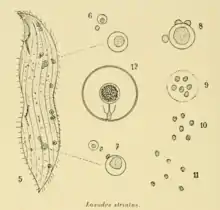Loxodidae
Loxodidae members possess an elongated, laterally flattened shape. They share two key characters: a beak-like anterior rostrum interrupting the perioral kineties, and peculiar cytoplasmic organelles named Müller vesicles.[2]
| Loxodidae | |
|---|---|
 | |
| Loxodes | |
| Scientific classification | |
| Clade: | SAR |
| Infrakingdom: | Alveolata |
| Phylum: | Ciliophora |
| Subphylum: | Postciliodesmatophora |
| Class: | Karyorelictea |
| Order: | Loxodida |
| Family: | Loxodidae Bütschli, 1889 |
| Genera | |
Loxodidae is a family of karyorelict ciliates.[1]
The extensive development of lacunae of the smooth endoplasmic reticulum leads to strong vacuolization of the endoplasm. This feature is associated to a lack of contractile vacuoles in all loxodids.[3]
The term Loxodidae derives from the ancient greek λοξός (loxós), meaning "oblique, tilted".[4][5]
Gravitaxis

Loxodidae members possess the ability to orient themselves in oxygen gradients. They use gravity as a stimulus for this spatial orientation, a phenomenon called gravitaxis or geotaxis. Loxodid ciliates must therefore have developed mechanoreceptors informing them about what is up or down. A likely candidate structure is the Müller vesicle.
Müller vesicles (also known as Müllerian vesicles, or Mueller vesicles) are statocyst-like organelles uniquely found in ciliates of the family Loxodidae. They are named after the Danish zoologist Otto Friedrich Müller. Eugène Penard was the first to propose that these vesicles were analogous to statocysts, which are the gravity-sensing structures of animals.[6][7] Each Müller vesicle is spherical, about 7 µm across (in Loxodes), and is bounded by a membrane. It contains a Müller body, which comprises mineral concretions in an organic matrix bounded by a membrane, that is suspended in a vacuole by a stalk. The stalk is about 0.3–0.4 µm thick, and contains microtubules that connect the Müller body with the adjacent kinety, which is believed to help transmit the sensory signal to the rest of the cell.[8] The mineral concretions are mostly salts of strontium in the genus Remanella, but barium in Loxodes.[9]
Phylogeny
Molecular phylogeny based on sequences of the SSU rRNA gene indicates that Remanella and Loxodes branch together into a monophyletic family Loxodidae.[10]
References
- "WoRMS - World Register of Marine Species - Loxodidae Bütschli, 1889". www.marinespecies.org. Retrieved 2017-02-15.
- Kim, Ji-Hye; Kwon, Choon-Bong; Yoon, Jae-Sool; Shin, Mann-Kyoon (2009). "First Record of Three Loxodes Ciliates (Ciliophora: Loxodida: Loxodidae) from Korea". Animal Systematics, Evolution and Diversity. 25 (3): 301–308. doi:10.5635/kjsz.2009.25.3.301.
- Raikov, Igor B. (1994). "Somatic Cortical and Endoplasmic Fine Structure of Remanella granulosa Kahl (Ciliophora, Karyorelictida)". Archiv für Protistenkunde. 144: 7–16. doi:10.1016/S0003-9365(11)80217-4.
- Bailly, Anatole (1981-01-01). Abrégé du dictionnaire grec français. Paris: Hachette. ISBN 978-2010035289. OCLC 461974285.
- Bailly, Anatole. "Greek-french dictionary online". www.tabularium.be. Retrieved 2017-01-24.
- Genève., Muséum d'histoire naturelle de; Gesellschaft., Schweizerische Zoologische (1917). "Revue suisse de zoologie". Revue Suisse de Zoologie et Annales du Musée d'Histoire Naturelle de Genève. Kundig [etc.] t.25 (1917). ISSN 0035-418X.
- Fauré-Fremiet, E.; Gauchery, M. (1957-05-01). "Concrétions Minérales Intracytoplasmiques chez les Ciliés". The Journal of Protozoology. 4 (2): 96–109. doi:10.1111/j.1550-7408.1957.tb02493.x. ISSN 1550-7408.
- Fenchel, Tom; Finlay, Bland J. (1986-02-01). "The Structure and Function of Müller Vesicles in Loxodid Ciliates". The Journal of Protozoology. 33 (1): 69–76. doi:10.1111/j.1550-7408.1986.tb05560.x. ISSN 1550-7408.
- Rieder, Norbert; Ott, Hubert A.; Pfundstein, Peter; Schoch, Robert (1982-02-01). "X-ray Microanalysis of the Mineral Contents of Some Protozoa". The Journal of Protozoology. 29 (1): 15–18. doi:10.1111/j.1550-7408.1982.tb02875.x. ISSN 1550-7408.
- Xu, Yuan; Gao, Shan; Hu, Xiaozhong; Al-Rasheid, Khaled A. S.; Song, Weibo (2013-08-01). "Phylogeny and systematic revision of the karyorelictid genus Remanella (Ciliophora, Karyorelictea) with descriptions of two new species". European Journal of Protistology. 49 (3): 438–452. doi:10.1016/j.ejop.2012.12.001. PMID 23434324.
External links
 Data related to Loxodidae at Wikispecies
Data related to Loxodidae at Wikispecies